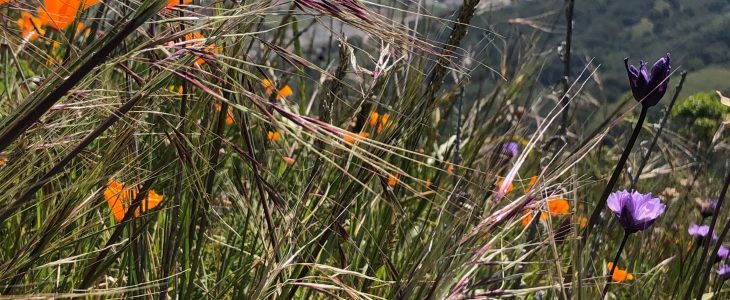
Purple needle grass (Stipa pulchra) in a garden setting evokes a sense of a wilder place. The flowers have a slight tinge of purple and a lovely silvery shimmer seen en masse from a distance, creating a pleasing effect on the spring breeze. In a mixed border with annual wildflowers, perennials and native “bulbs”, purple needle grass gives the feeling of time spent wandering in the hills. Many of us never think much about grasses but somehow feel comforted when our grassland cloaked hills turn green at the onset of winter rain. As spring stretches into summer, distinct clumps of this perennial bunch grass extend two- three foot long flowering stems above their leaf blades. The flowers of a grass look from a distance like already formed seed. But if you move in close you will see, if your timing is right, tiny open florets with feathery stamens dangling, doing the important reproductive job of casting pollen to the wind.
Purple needle grass is a key grassland species throughout the central valley, surrounding foothills, and along the central coast south to Baja. Bay area rangeland specialist David Amme estimates that two thirds of the east bay was once dominated by open grassland and oak savanna. In 2004 purple needle grass was named our state grass to highlight its importance to Native Americans, wildlife, habitat restoration, revegetation and rangeland management.
Plants in the grass family cover huge swaths of the planet in biomes known by the terms prairie, grassland, marsh, steppe, pasture, and cropland. Grasses are classified taxonomically in one of the largest and most important plant families Poaceae. There are both perennial and annual grass species. All grasses are herbaceous (non-woody) with the exception of bamboo. The perennials are either clumping (as in perennial bunch grass) or sod forming. Of course, as in any rule, there are exceptions with a few species having a simultaneous clumping and running growth habit. Perennial bunch grasses are noted for their extensive fibrous root systems reaching deep into often poor soils. For this reason they are of key importance in erosion control. Native perennial bunch grasses are adapted to grazing by wild elk and deer. Elk and other wild ruminants browse the tops of plants leaving the lower leaves and root crowns intact. Domesticated grazers are not so polite and if left too long in one pasture or field will graze a grass plant down past the root crown often times killing the plant. Perennial bunch grasses are well adapted to fire, fast moving surface fires can have the effect of refreshing a stand of bunch grass if the root crowns survive a not too hot singe. Purple needle grass seed is attached to a long bristle (awn) which develops two kinks as the seed and awn dry out. Changes in air moisture cause the awn to alternately twist and untwist over several days sending the seed down to plant itself in the soil. The self planting seeds are then protected from birds, mice and wildfire. Individual plants in some situations can live 100 or more years.
Purple needle grass is easy to grow in the right spot in the garden. Local gardeners will be happy to know that it thrives in clay soils. Once established, this deep rooted long lived perennial needs water once a month or less. Stipa pulchra does best in full sun though it can also take a few hours of light shade. The big question about gardening with bunch grasses is maintenance. Our clues come to us from the plant’s adaptation to browsing by ruminants and wildfire. Since its growth points are close to the soil surface the tops can be cut back to within an inch or two of the ground. This treatment once every year or two during fall clean-up reinvigorates the plant and avoids the awkward looking straw stumps created by pruning higher up the stems. Of course if you wish for less intensive intervention in your garden, leaving the dormant clump in tact is an option though lightly raking out the build up of dead leaves or thatch is recommended. Be sure to do the raking well after nesting season to avoid disturbing any ground nesting birds!
By Kristen Hopper
Oaktown Native Plant Nursery
Reference materials:
Califlora, ed. Terry Beers. Berkeley: Heyday Books, 2012.
Wild Lilies, Irises and Grasses, ed. Nora Harlow and Kristin Jakob. Berkeley: UC Press, 2003.
The Drought Defying California Garden, by Greg Rubin and Lucy Warren. Portland, OR: Timber Press, 2016.
Calscape.org